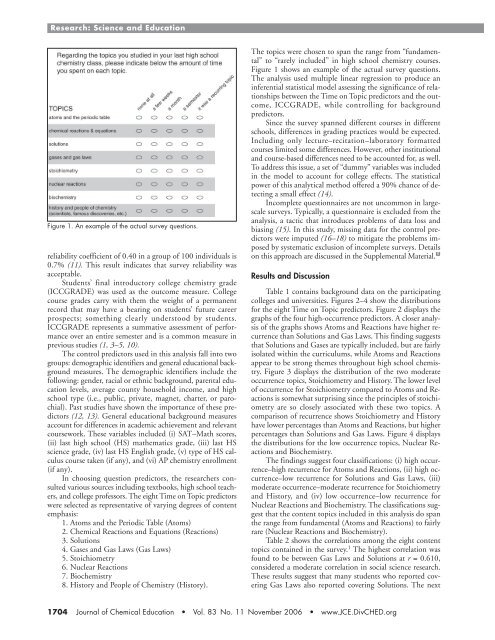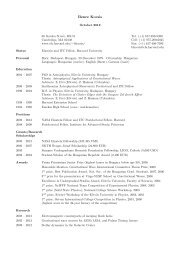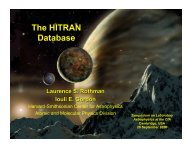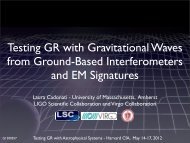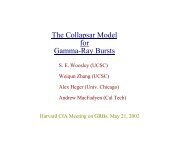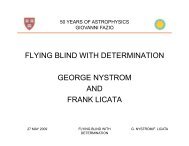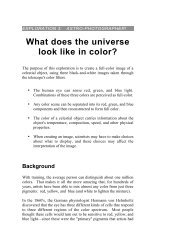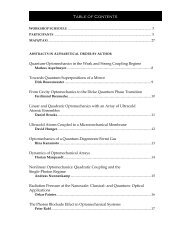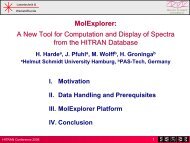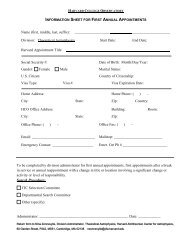High School Chemistry Content Background of Introductory College ...
High School Chemistry Content Background of Introductory College ...
High School Chemistry Content Background of Introductory College ...
Create successful ePaper yourself
Turn your PDF publications into a flip-book with our unique Google optimized e-Paper software.
Research: Science and Education<br />
Figure 1. An example <strong>of</strong> the actual survey questions.<br />
reliability coefficient <strong>of</strong> 0.40 in a group <strong>of</strong> 100 individuals is<br />
0.7% (11). This result indicates that survey reliability was<br />
acceptable.<br />
Students’ final introductory college chemistry grade<br />
(ICCGRADE) was used as the outcome measure. <strong>College</strong><br />
course grades carry with them the weight <strong>of</strong> a permanent<br />
record that may have a bearing on students’ future career<br />
prospects; something clearly understood by students.<br />
ICCGRADE represents a summative assessment <strong>of</strong> performance<br />
over an entire semester and is a common measure in<br />
previous studies (1, 3–5, 10).<br />
The control predictors used in this analysis fall into two<br />
groups: demographic identifiers and general educational background<br />
measures. The demographic identifiers include the<br />
following: gender, racial or ethnic background, parental education<br />
levels, average county household income, and high<br />
school type (i.e., public, private, magnet, charter, or parochial).<br />
Past studies have shown the importance <strong>of</strong> these predictors<br />
(12, 13). General educational background measures<br />
account for differences in academic achievement and relevant<br />
coursework. These variables included (i) SAT–Math scores,<br />
(ii) last high school (HS) mathematics grade, (iii) last HS<br />
science grade, (iv) last HS English grade, (v) type <strong>of</strong> HS calculus<br />
course taken (if any), and (vi) AP chemistry enrollment<br />
(if any).<br />
In choosing question predictors, the researchers consulted<br />
various sources including textbooks, high school teachers,<br />
and college pr<strong>of</strong>essors. The eight Time on Topic predictors<br />
were selected as representative <strong>of</strong> varying degrees <strong>of</strong> content<br />
emphasis:<br />
1. Atoms and the Periodic Table (Atoms)<br />
2. Chemical Reactions and Equations (Reactions)<br />
3. Solutions<br />
4. Gases and Gas Laws (Gas Laws)<br />
5. Stoichiometry<br />
6. Nuclear Reactions<br />
7. Biochemistry<br />
8. History and People <strong>of</strong> <strong>Chemistry</strong> (History).<br />
The topics were chosen to span the range from “fundamental”<br />
to “rarely included” in high school chemistry courses.<br />
Figure 1 shows an example <strong>of</strong> the actual survey questions.<br />
The analysis used multiple linear regression to produce an<br />
inferential statistical model assessing the significance <strong>of</strong> relationships<br />
between the Time on Topic predictors and the outcome,<br />
ICCGRADE, while controlling for background<br />
predictors.<br />
Since the survey spanned different courses in different<br />
schools, differences in grading practices would be expected.<br />
Including only lecture–recitation–laboratory formatted<br />
courses limited some differences. However, other institutional<br />
and course-based differences need to be accounted for, as well.<br />
To address this issue, a set <strong>of</strong> “dummy” variables was included<br />
in the model to account for college effects. The statistical<br />
power <strong>of</strong> this analytical method <strong>of</strong>fered a 90% chance <strong>of</strong> detecting<br />
a small effect (14).<br />
Incomplete questionnaires are not uncommon in largescale<br />
surveys. Typically, a questionnaire is excluded from the<br />
analysis, a tactic that introduces problems <strong>of</strong> data loss and<br />
biasing (15). In this study, missing data for the control predictors<br />
were imputed (16–18) to mitigate the problems imposed<br />
by systematic exclusion <strong>of</strong> incomplete surveys. Details<br />
on this approach are discussed in the Supplemental Material. W<br />
Results and Discussion<br />
Table 1 contains background data on the participating<br />
colleges and universities. Figures 2–4 show the distributions<br />
for the eight Time on Topic predictors. Figure 2 displays the<br />
graphs <strong>of</strong> the four high-occurrence predictors. A closer analysis<br />
<strong>of</strong> the graphs shows Atoms and Reactions have higher recurrence<br />
than Solutions and Gas Laws. This finding suggests<br />
that Solutions and Gases are typically included, but are fairly<br />
isolated within the curriculums, while Atoms and Reactions<br />
appear to be strong themes throughout high school chemistry.<br />
Figure 3 displays the distribution <strong>of</strong> the two moderate<br />
occurrence topics, Stoichiometry and History. The lower level<br />
<strong>of</strong> occurrence for Stoichiometry compared to Atoms and Reactions<br />
is somewhat surprising since the principles <strong>of</strong> stoichiometry<br />
are so closely associated with these two topics. A<br />
comparison <strong>of</strong> recurrence shows Stoichiometry and History<br />
have lower percentages than Atoms and Reactions, but higher<br />
percentages than Solutions and Gas Laws. Figure 4 displays<br />
the distributions for the low occurrence topics, Nuclear Reactions<br />
and Biochemistry.<br />
The findings suggest four classifications: (i) high occurrence–high<br />
recurrence for Atoms and Reactions, (ii) high occurrence–low<br />
recurrence for Solutions and Gas Laws, (iii)<br />
moderate occurrence–moderate recurrence for Stoichiometry<br />
and History, and (iv) low occurrence–low recurrence for<br />
Nuclear Reactions and Biochemistry. The classifications suggest<br />
that the content topics included in this analysis do span<br />
the range from fundamental (Atoms and Reactions) to fairly<br />
rare (Nuclear Reactions and Biochemistry).<br />
Table 2 shows the correlations among the eight content<br />
topics contained in the survey. 1 The highest correlation was<br />
found to be between Gas Laws and Solutions at r 0.610,<br />
considered a moderate correlation in social science research.<br />
These results suggest that many students who reported covering<br />
Gas Laws also reported covering Solutions. The next<br />
1704 Journal <strong>of</strong> Chemical Education • Vol. 83 No. 11 November 2006 • www.JCE.DivCHED.org


